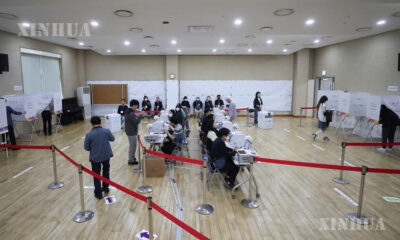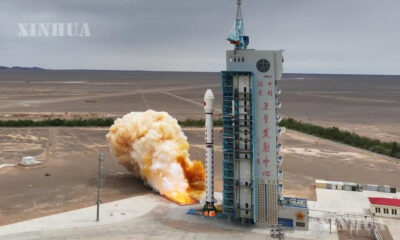Asia
တောင်ကိုရီးယားနိုင်ငံက ပထမဆုံး ပြည်တွင်းဖြစ်ဒုံးပျံ လွှတ်တင်

ဆိုးလ်၊ အောက်တိုဘာ ၂၂ ရက် (ဆင်ဟွာ)
တောင်ကိုရီးယားနိုင်ငံက ပထမဆုံးပြည်တွင်းဖြစ် အာကာသလွှတ်တင်ရေးယာဉ်အား အောက်တိုဘာ ၂၁ ရက်က စမ်းသပ်ပစ်လွှတ်ခဲ့ကြောင်း၊ သို့ရာတွင် ယင်းဒုံးပျံက စမ်းသပ်ဂြိုဟ်တုတစ်လုံးအား အနိမ့်ပိုင်း ကမ္ဘာပတ်လမ်းကြောင်း (ကီလိုမီတာ ၆၀၀-၈၀၀) အတွင်းသို့ လွှတ်တင်ရာတွင် မအောင်မြင်ခဲ့ကြောင်း သိရသည်။အဆိုပါ ပြည်တွင်းထုတ် ဒုံးပျံသည် ပျံသန်းမှုကွင်းဆက်အားလုံး ပြီးစီးခဲ့ကြောင်း၊ သို့ရာတွင် ၎င်းစမ်းသပ်ဂြိုဟ်တုမှာ မပြီးဆုံးသော တာဝန်အဖြစ် ဂြိုဟ်ပတ်လမ်းကြောင်းအတွင်း ဆက်လက်ရှိနေမည်ဖြစ်ကြောင်း တောင်ကိုရီးယားနိုင်ငံ သမ္မတ မွန်ဂျေအင်က အာကာသစင်တာတွင် ရုပ်သံမိန့်ခွန်း၌ ပြောကြားခဲ့သည်။

တောင်ကိုရီးယားနိုင်ငံ Goheung ကမ်းရိုးတန်းကျေးရွာရှိ နာရို အာကာသစင်တာမှ KSLV-II ဒုံးပျံအား အောက်တိုဘာ ၂၁ ရက်က လွှတ်တင်နေသည်ကို တွေ့ရစဉ် (ဓာတ်ပုံ- Korea Aerospace Research Institute/Handout via Xinhua)
မွန်က လာမည့်နှစ် မေလတွင် လွှတ်တင်ရန် လျာထားသော Nuri ဂြိုဟ်တု၏ နောက်ထပ်စမ်းသပ်လွှတ်တင်မှုမှာ အောင်မြင်မှုရရှိနိုင်ပြီး အာကာသတွင် ပင်လယ်ရေမျက်နှာပြင်အထက် ကီလိုမီတာ ၇၀၀ အထိ ရောက်ရှိနိုင်မည်ဟု မျှော်မှန်းထားကြောင်း ပြောကြားခဲ့သည်။

တောင်ကိုရီးယားနိုင်ငံ Goheung ကမ်းရိုးတန်းကျေးရွာရှိ နာရို အာကာသစင်တာမှ KSLV-II ဒုံးပျံအား အောက်တိုဘာ ၂၁ ရက်က လွှတ်တင်နေသည်ကို တွေ့ရစဉ် (ဓာတ်ပုံ- Korea Aerospace Research Institute/Handout via Xinhua)
တောင်ကိုရီးယားနိုင်ငံ၏ ပထမဆုံး ပြည်တွင်းဖြစ်ဒုံးပျံသည် ဒီဇိုင်းထုတ်လုပ်ခြင်းနှင့် တည်ဆောက်ခြင်း လုပ်ငန်းစဉ်တစ်ခုလုံးကို ပြည်တွင်း၌ ပြုလုပ်ထားခြင်း ဖြစ်သည်။
တောင်ကိုရီးယားနိုင်ငံသည် လွန်ခဲ့သည့်ဆယ်စုနှစ်အတွင်း ပြည်တွင်းထုတ် အာကာသယာဉ် ထုတ်လုပ်ရန် ဝမ် ၂ ထရီလီယံ (အမေရိကန်ဒေါ်လာ ၁.၇ ဘီလီယံ) နီးပါး ရင်းနှီးမြှုပ်နှံထားကြောင်း သိရသည်။
လူပေါင်း ၅၀၀ ခန့်စုပေါင်းထားပြီး အဓိကကုမ္ပဏီ ၃၀ ခန့်ပါဝင်သော ပြည်တွင်းကုမ္ပဏီ ၃၀၀ ခန့်သည် အနိမ့်ပိုင်း ကမ္ဘာပတ်လမ်းကြောင်းအတွင်းသို့ အလေးချိန် ၁.၅ တန်ရှိသော လက်တွေ့စမ်းသပ်မှုဂြိုဟ်တုတစ်ခု လွှတ်တင်နိုင်သည့် အာကာသယာဉ်တည်ဆောက်မှု၌ ပါဝင်ခဲ့ကြောင်း သိရသည်။
အရွယ်အစားအားဖြင့် အလျား ၄၇.၂ မီတာနှင့် အများဆုံးအချင်းဝက် ၃.၅ မီတာရှိပြီး တန် ၂၀၀ အလေးချိန်ရှိသော Nuri အာကာသဒုံးပျံသည် ပထမအဆင့်တွင် ၇၅-တန်-ဂရိတ်-အရည်အင်ဂျင် လေးလုံး၊ ဒုတိယအဆင့်တွင် ၇၅-တန်-ဂရိတ်-အရည် အင်ဂျင်တစ်လုံးနှင့် တတိယအဆင့်တွင်မူ ၇-တန်-ဂရိတ်အင်ဂျင်တစ်လုံး စုပေါင်းထားကြောင်း သိရသည်။
ပြည်တွင်းထုတ် အာကာသဒုံးပျံ ထုတ်လုပ်မှုစီမံကိန်းအား ၂၀၁၀ ပြည်နှစ်တွင် စတင်ခဲ့ခြင်းဖြစ်ပြီး ၂၀၁၈ ခုနှစ် နိုဝင်ဘာလ၌ KSLV-TLV ဟု အမည်ပေးထားသော ၇၅-တန်-ဂရိတ် အရည်အင်ဂျင်ကို အောင်မြင်စွာ စမ်းသပ်လွှတ်တင်ခဲ့ကြောင်း သိရသည်။
ကိုရီးယား အာကာသယာဉ် တည်ဆောက်မှုနည်းပညာအင်စတီကျု (KARI) အနေဖြင့် ၂၀၂၇ ခုနှစ်မတိုင်မီ Nuri အာကာယာဉ် နောက်ထပ်ငါးကြိမ် လွှတ်တင်ရန် စီစဉ်ထားသည်။
Nuri ဟုလည်း အမည်ပေးထားသော KSLV-II ဒုံးပျံအား နိုင်ငံတောင်ပိုင်း Goheung ကမ်းရိုးတန်းကျေးရွာရှိ နာရို အာကာသစင်တာမှ အောက်တိုဘာ ၂၁ ရက် ဒေသစံတော်ချိန် ညနေ ၅:၀၀ နာရီ၌ လွှတ်တင်ခဲ့ခြင်းဖြစ်ကြောင်း ကိုရီးယား အာကာသယာဉ် တည်ဆောက်မှုနည်းပညာအင်စတီကျု (KARI) က တွင် ရုပ်သံရိုက်ကူးမှု၌ ဖော်ပြထားသည်။
လွှတ်တင်ပြီးနောက် အဆင့်သုံးဆင့်ပါသော ဒုံးပျံသည် တောင်ဘက်သို့ ပျံသန်းသွားပြီး ပထမအင်ဂျင်တွန်းကန်အားတွင် ပင်လယ်ရေမျက်နှာပြင်အထက် ၅၉ ကီလိုမီတာသို့ ရောက်ရှိခဲ့ကာ ညနေ ၅:၀၈ နာရီခန့်၌ ပင်လယ်ရေမျက်နှာပြင်အထက် ၆၀၀ ကီလိုမီတာအထိ ရောက်ရှိသွားကြောင်း၊ တတိယအဆင့် အားဖြည့်အင်ဂျင်တွန်းကန်အားသည် ၅:၁၂ နာရီတွင် ရပ်တန့်သွားခဲ့ကာ ဂြိုဟ်တုမှာ ညနေ ၅:၁၅ မိနစ်၌ ဒုံးပျံမှ ခွဲထွက်သွားခဲ့သည်။
သို့ရာတွင် အလေးချိန် ၁.၅ တန်ရှိသော စမ်းသပ်ဂြိုဟ်တုသည် စီစဉ်ထားသည့်အတိုင်း နေပတ်လမ်းကြောင်းအတွင်း ဝင်ရောက်ရာတွင် မအောင်မြင်ခဲ့ကြောင်း သိရသည်။
KARI သည် ကာလရှည်တွင် ၈၂-တန်-ဂရိတ် အင်ဂျင်တွန်းကန်အားရှိသော ပိုမိုစွမ်းဆောင်ရည်မြင့်မားသည့် အဓိကအင်ဂျင် ထုတ်လုပ်ခြင်းဖြင့် အနိမ့်ပိုင်းဂြိုဟ်ပတ်လမ်းကြောင်းအတွင်းသို့ အလေးချိန် ၂.၈ တန်ရှိသော ဂြိုဟ်တုတစ်လုံး သယ်ဆောင်သွားနိုင်ရန် Nuri ၏ လုပ်ဆောင်နိုင်စွမ်းကို မြှင့်တင်ရန် စီစဉ်ထားကြောင်း သိရသည်။
၂၀၂၉ ခုနှစ်တွင် အဆင့်မြှင့်တင်ထားသော အာကာသယာဉ် နှစ်ကြိမ် စမ်းသပ်လွှတ်တင်ရန်၊ ၂၀၃၀ ပြည့်နှစ်မတိုင်မီ ၈၃၀-ကီလိုဂရမ်ရှိသော လကမ္ဘာသွားအာကာသယာဉ် လွှတ်တင်မှု သေချာစေရန် ရည်ရွယ်ထားည်ဟု ဆိုသည်။
တောင်ကိုရီးယားနိုင်ငံသည် နာရို ဟု လူသိများသော ပထမဆုံး KSLV-I အာကာသယာဉ်အား ၂၀၁၃ ခုနှစ် ဇန်နဝါရီလက စမ်းသပ်လွှတ်တင်ရာ အောင်မြင်ခဲ့ကြောင်း၊ သို့ရာတွင် အဆင့်နှစ်ဆင့်ပါဝင်သော ၎င်းယာဉ်၏ ပထမအဆင့် အင်ဂျင်ကို ရုရှားနိုင်ငံ၌ တည်ဆောက်ထားခြင်း ဖြစ်ကြောင်း သိရသည်။ (Xinhua)
———————————————–
(English Version)
S.Korea launches 1st homegrown rocket
Source: Xinhua| 2021-10-21 19:10:57|Editor: huaxia
SEOUL, Oct. 21 (Xinhua) — South Korea test-launched its first homegrown space launch vehicle Thursday, but the rocket failed to put a dummy satellite into the low-Earth orbit (600-800 km).
The KSLV-II, also dubbed Nuri, blasted off from the Naro Space Center in the southern coastal village of Goheung at 5:00 p.m. local time (0800 GMT) on Thursday, live footage from the Korea Aerospace Research Institute (KARI) showed.
After the liftoff, the three-stage space rocket flew south to reach an altitude of 59 km in the first thrust section and an altitude of 600 km at about 5:08 p.m. The third-stage booster engine stopped at 5:12 p.m., and the satellite was separated from the booster at 5:15 p.m.
However, the 1.5-ton dummy satellite failed to be put into the sun synchronous orbit as planned.
South Korean President Moon Jae-in told a televised speech at the space center that the homegrown rocket finished all of its flight sequence, but he noted that putting the dummy satellite into orbit remained as an unfinished task to be tackled.
Moon said it was something to brag about to send the rocket up at an altitude of 700 km in space, expecting that the next test-launch of Nuri, scheduled for May next year, could achieve a complete success.
It was South Korea’s first test-launch of its homegrown rocket that was entirely designed and built in the country.
South Korea invested nearly 2 trillion won (1.7 billion U.S. dollars) for the past decade to indigenously develop the space launch vehicle.
About 300 local companies, including some 30 major companies comprising around 500 people, participated in the development of the space vehicle that can deploy a 1.5-ton practical satellite into the low-Earth orbit.
The 200-ton Nuri space rocket, which measures 47.2 meters in length and 3.5 meters in maximum diameter, was clustered by four 75-ton-grade liquid engines in the first stage, a 75-ton-grade liquid engine in the second stage and a 7-ton-grade liquid engine in the third stage.
The homegrown space rocket development project began in March 2010, and the country successfully test-launched its indigenous 75-ton-grade liquid engine, called KSLV-TLV, in November 2018.
KARI plans to test-launch the Nuri space launch vehicle five more times by 2027 to secure reliability.
In the long term, KARI plans to enhance the Nuri performance to carry a 2.8-ton satellite into the low orbit by developing a higher-performance main engine of 82-ton-grade thrust.
It also aims to test-launch the enhanced space launch vehicle twice in 2029 and 2030, and secure an 830-kg moon probe launch performance by 2030.
In January 2013, South Korea succeeded in test-launching its first-ever KSLV-I space launch vehicle, also known as Naro, but the first-stage booster engine of the two-stage vehicle was built in Russia. Enditem
1- 2 -3 – A KSLV-II rocket is launched from the Naro Space Center in Goheung, South Korea, Oct. 21, 2021. South Korea test-launched its first homegrown space launch vehicle Thursday, but the rocket failed to put a dummy satellite into the low-Earth orbit (600-800 km). The KSLV-II, also dubbed Nuri, blasted off from the Naro Space Center in the southern coastal village of Goheung at 5:00 p.m. local time (0800 GMT) on Thursday, live footage from the Korea Aerospace Research Institute (KARI) showed. (Korea Aerospace Research Institute/Handout via Xinhua)






